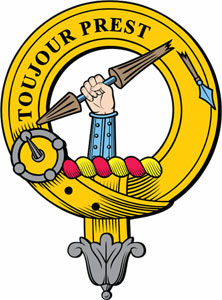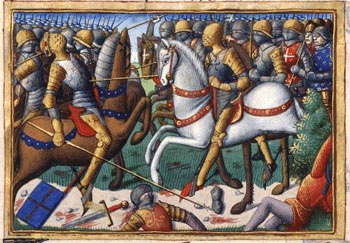In part five of this series, Rodger Moffet of ScotClans tells the story of how Clan Carmichael came to have the broken lance as their crest image.

The Carmichaels were a large and powerful landowning family from the Southern Uplands of Scotland. They occupied land around Lanarkshire for over 800 years and had strong ties with the equally powerful Douglas clan.
The crest for Carmichael depicts a broken lance, A reference to an act of valour carried out by one of the clan during the hundred years war.
Background:
The Hundred years war was really a series of conflicts that ran from 1337 to 1453 (that’s 116 years if you are counting). The war was between England and France and had been a throwback to the earlier Norman invasions. England having been conquered by the Normans had an strange relationship with the old country and any French property still owned by English Kings were considered to be Vassal states of France. Not only that but whenever England’s back was turned (literally) while fighting the Scots the French would chip off little bits of Anglo owned French territory. This interference was grimly tolerated until the French had an issue with succession and Edward III of England decided to weigh in.
The Hundred years war was really an epic conflict. It is from this time that characters like Joan of Arc, The Black Prince and Henry V hail from. The war itself tends to be divided into three stages, known as the Edwardian, Caroline and Lancastrian Wars. A novice of history would easily be led to believe that the war was England’s finest moment, famous victories like Crecy and Agincourt are well known through popular tales but these were early English victories and ultimately France came out on top. Another aside to the hundred years war is the effect this had on the rest of Europe with other conflicts spilling over into Spain like some sort of giant cowboy bar fight.
For this story we need to focus on the later stages of the conflict.
Scotland had been in an alliance with France since 1295, an arrangement which tended to favour France as the major power rather than impoverished Scotland who still had to fend off England’s constant harassment. For the next few centuries Scotland and France ran a sort of tag team effort on England, While France headed towards all out war, the Scots took on a sniping roll, better suited to the resources available.
However by 1419 the situation in France was not going well. The English victory at Agincourt had rocked the French, loosing Normandy and Paris. They were locked in a civil war with the Dukes of Burgundy and with the score at 1 each in the previous phases and going into the final round it wasn’t looking good. With the situation desperate the French appealed to Scotland for help. The Scots ever keen to have a go at the English duly obliged and John Stewart, 2nd Earl of Buchan gathered an army to set off for France.
Henry V of England had gone back to France after his marriage to Cathrine of Valois leaving his younger brother Thomas of Lancaster, 1st Duke of Clarence in charge. Clarence lead the English army on a series of raids through Anjou and Maine and on 21st March 1421 they had made camp near the town of Vieil-Baugé. The Scots and French combined force arrived at the same time to block their progress. Unfortunately this was Good Friday and it was against the laws of engagement to go to battle during the Easter religious festival. A truce had been agreed till after Easter Monday but Clarence decided to break the agreement and attack on the Saturday taking the element of surprise.
This was a disaster for Clarence.

The initial attack over a bridge was easily repelled as the English forces were still not all ready to deploy. This gave the Scots time to rally the rest of their forces. Clarence had completely misread the size of the Scots-French army and had no idea it was up to 5,000 strong. Clarence finally managed to force his knights over the bridge but ran headlong into the main Scots force. He was charged by the Scots force and John Carmichael of Douglasdale unhorsed the Duke with his lance, breaking it in the process. Sir John Swinton of the Scots then struck a blow to Clarence’s face and Alexander Buchanan Finished him off with his mace, taking the Duke’s coronet and hoisting it on his lance for the rest of the army to see.
The English force were routed and most were able to escape (in fact 2,500 of them were never even deployed) English casualties numbers 1,000 dead and 500 captured against a fairly insignificant opposing losses.
The measure of the victory was to cement the Scots’ reputation as a fighting force and many Scots nobles were well rewarded for their efforts.
And so Carmichaels everywhere commemorate this deed in a foreign war with the symbol of the broken lance. Nowadays we tend to think of the lance as a jousting weapon but with the development of the high back saddle a mounted knight could transfer all his momentum into the lance point making it a devastating tool in the correct hands. One can only imagine the blow that struck the Duke of Clarence that day at the battle of Baugé

That is interesting history. I am trying to find out more information about my ancestorJohn Carmichael born February 6th, 1834 in Dumfries, Scotland. I can’t seem to find out who his parents are?
Phyllis,
The reply from Bernadette is absolutely correct.
George Carmichael and Isabella Kerr were my gr,gr grandparents.
I have done a lot of research on our ancestors.
Let me know if you want to know more
tomcarmichael@virginmedia.com
Best
Tom
CARMICHAEL
JOHN
GEORGE CARMICHAEL/ISABELLA KERR FR171 (FR171)
M
26/02/1834
844/
20 34
Mouswald Dumfries